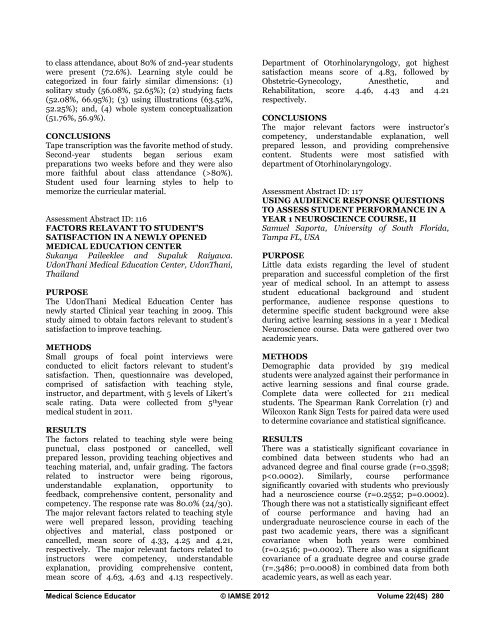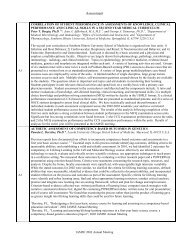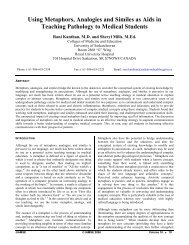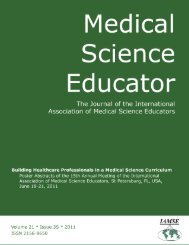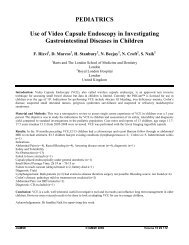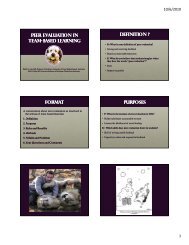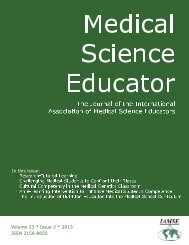Click here to view complete journal in pdf-format - IAMSE
Click here to view complete journal in pdf-format - IAMSE
Click here to view complete journal in pdf-format - IAMSE
You also want an ePaper? Increase the reach of your titles
YUMPU automatically turns print PDFs into web optimized ePapers that Google loves.
<strong>to</strong> class attendance, about 80% of 2nd-year students<br />
were present (72.6%). Learn<strong>in</strong>g style could be<br />
categorized <strong>in</strong> four fairly similar dimensions: (1)<br />
solitary study (56.08%, 52.65%); (2) study<strong>in</strong>g facts<br />
(52.08%, 66.95%); (3) us<strong>in</strong>g illustrations (63.52%,<br />
52.25%); and, (4) whole system conceptualization<br />
(51.76%, 56.9%).<br />
CONCLUSIONS<br />
Tape transcription was the favorite method of study.<br />
Second-year students began serious exam<br />
preparations two weeks before and they were also<br />
more faithful about class attendance (>80%).<br />
Student used four learn<strong>in</strong>g styles <strong>to</strong> help <strong>to</strong><br />
memorize the curricular material.<br />
Assessment Abstract ID: 116<br />
FACTORS RELAVANT TO STUDENT’S<br />
SATISFACTION IN A NEWLY OPENED<br />
MEDICAL EDUCATION CENTER<br />
Sukanya Paileeklee and Supaluk Raiyawa.<br />
UdonThani Medical Education Center, UdonThani,<br />
Thailand<br />
PURPOSE<br />
The UdonThani Medical Education Center has<br />
newly started Cl<strong>in</strong>ical year teach<strong>in</strong>g <strong>in</strong> 2009. This<br />
study aimed <strong>to</strong> obta<strong>in</strong> fac<strong>to</strong>rs relevant <strong>to</strong> student’s<br />
satisfaction <strong>to</strong> improve teach<strong>in</strong>g.<br />
METHODS<br />
Small groups of focal po<strong>in</strong>t <strong>in</strong>ter<strong>view</strong>s were<br />
conducted <strong>to</strong> elicit fac<strong>to</strong>rs relevant <strong>to</strong> student’s<br />
satisfaction. Then, questionnaire was developed,<br />
comprised of satisfaction with teach<strong>in</strong>g style,<br />
<strong>in</strong>struc<strong>to</strong>r, and department, with 5 levels of Likert’s<br />
scale rat<strong>in</strong>g. Data were collected from 5 th year<br />
medical student <strong>in</strong> 2011.<br />
RESULTS<br />
The fac<strong>to</strong>rs related <strong>to</strong> teach<strong>in</strong>g style were be<strong>in</strong>g<br />
punctual, class postponed or cancelled, well<br />
prepared lesson, provid<strong>in</strong>g teach<strong>in</strong>g objectives and<br />
teach<strong>in</strong>g material, and, unfair grad<strong>in</strong>g. The fac<strong>to</strong>rs<br />
related <strong>to</strong> <strong>in</strong>struc<strong>to</strong>r were be<strong>in</strong>g rigorous,<br />
understandable explanation, opportunity <strong>to</strong><br />
feedback, comprehensive content, personality and<br />
competency. The response rate was 80.0% (24/30).<br />
The major relevant fac<strong>to</strong>rs related <strong>to</strong> teach<strong>in</strong>g style<br />
were well prepared lesson, provid<strong>in</strong>g teach<strong>in</strong>g<br />
objectives and material, class postponed or<br />
cancelled, mean score of 4.33, 4.25 and 4.21,<br />
respectively. The major relevant fac<strong>to</strong>rs related <strong>to</strong><br />
<strong>in</strong>struc<strong>to</strong>rs were competency, understandable<br />
explanation, provid<strong>in</strong>g comprehensive content,<br />
mean score of 4.63, 4.63 and 4.13 respectively.<br />
Department of O<strong>to</strong>rh<strong>in</strong>olaryngology, got highest<br />
satisfaction means score of 4.83, followed by<br />
Obstetric-Gynecology, Anesthetic, and<br />
Rehabilitation, score 4.46, 4.43 and 4.21<br />
respectively.<br />
CONCLUSIONS<br />
The major relevant fac<strong>to</strong>rs were <strong>in</strong>struc<strong>to</strong>r’s<br />
competency, understandable explanation, well<br />
prepared lesson, and provid<strong>in</strong>g comprehensive<br />
content. Students were most satisfied with<br />
department of O<strong>to</strong>rh<strong>in</strong>olaryngology.<br />
Assessment Abstract ID: 117<br />
USING AUDIENCE RESPONSE QUESTIONS<br />
TO ASSESS STUDENT PERFORMANCE IN A<br />
YEAR 1 NEUROSCIENCE COURSE, II<br />
Samuel Saporta, University of South Florida,<br />
Tampa FL, USA<br />
PURPOSE<br />
Little data exists regard<strong>in</strong>g the level of student<br />
preparation and successful completion of the first<br />
year of medical school. In an attempt <strong>to</strong> assess<br />
student educational background and student<br />
performance, audience response questions <strong>to</strong><br />
determ<strong>in</strong>e specific student background were akse<br />
dur<strong>in</strong>g active learn<strong>in</strong>g sessions <strong>in</strong> a year 1 Medical<br />
Neuroscience course. Data were gat<strong>here</strong>d over two<br />
academic years.<br />
METHODS<br />
Demographic data provided by 319 medical<br />
students were analyzed aga<strong>in</strong>st their performance <strong>in</strong><br />
active learn<strong>in</strong>g sessions and f<strong>in</strong>al course grade.<br />
Complete data were collected for 211 medical<br />
students. The Spearman Rank Correlation (r) and<br />
Wilcoxon Rank Sign Tests for paired data were used<br />
<strong>to</strong> determ<strong>in</strong>e covariance and statistical significance.<br />
RESULTS<br />
T<strong>here</strong> was a statistically significant covariance <strong>in</strong><br />
comb<strong>in</strong>ed data between students who had an<br />
advanced degree and f<strong>in</strong>al course grade (r=0.3598;<br />
p


